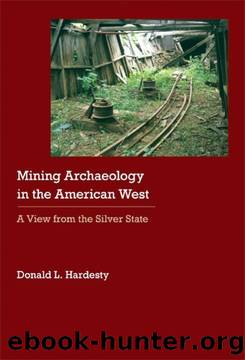Mining Archaeology in the American West: A View from the Silver State (Historical Archaeology of the American West) by Donald L. Hardesty

Author:Donald L. Hardesty
Language: eng
Format: epub
Published: 2011-12-23T00:20:00+00:00
Settlement-systems in the Cortez Mining District
The Cortez Mining District in north-central Nevada provides one example ofa mining-related social network embedded within a distinctive sociotechnical system. In the fall of1863, a party of nine prospectors led by Andrew A. Veatch organized the Cortez Mining District after the discovery of several ore veins on MountTenabo (Bancroft 1889:11; Cassell 1863). George Hearst was a major investor in the first mining company formed in the district, the Cortez Joint Stock Company (Bancroft 1889:12-13). By 1864, 6o or 70 men were in the district (Reese River Reveille 3 May 1864:1). The mining camps of Cortez Camp, St. Louis, and Shoshone Wells had been established as well by this time (Hattori et al. 1984:47), along with the Cortez Gold and Silver Mining Company (CGSMC) Mill near Cortez Camp in Mill Canyon (Reese River Reveille 7 May 1864:1). Simeon Wenban, a member of the original discovery party, was the mill superintendent.
Washoe pan amalgamation technology was installed in the CGSMC Mill but did not work because the Cortez ores were not free milling (Bancroft 1889:12). In 1865 workers added four reverberatory roasting furnaces to the mill technology, changing it to the Reese River process (Reese River Reveille 8 July 1867:1). In 1867 the mill contained 13 stamps, 4 furnaces, and 4 Varney pans (Reese River Reveille 3 January 1867:1). Despite several changes in technology, the mill failed and closed in 1868, along with most of the mining operations in the district (Raymond 1869:82). The Tenabo Mill and Mining Company (TMMC) purchased the mill, probably in 1869 (Whitehall 1875:47). Wenban owned the company, which was mining several claims on the Nevada Giant Ledge on the west slope ofMountTenabo and shipping the ore to the new mill by mule train.
The discovery of an important ore body at the Garrison Mine led to the construction nearby ofa new mill by the TMMC in 1886 (Bancroft 1889:16). Installed with Russell process equipment, the mill was one of the first on the mining frontier to use the new leaching technology (Bancroft 1889:20). It included Krom rolls for grinding ore, Bruckner's cylinders and an O'Hara furnace for roasting ore, and a short-line railroad (Bancroft 1889:20; Mining and Scientific Press 1920:803-804). A pipeline transported water for the new mill from a spring seven miles away, providing the stimulus for the formation of a new settlement named Cortez next to the mill. In 1888 the TMMC was transferred to a holding company in London under the name Cortez Mines, Ltd. (Reese River Reveille 5 March 1888:1). Between 1889 and 1891, the TMMC mining operation was leased to the Bewick-Moering Syndicate ofLondon (Lincoln 1923:86). The mining operation was returned to Wenban in 1892, but the mill closed in the same year. All mining in the district would stop by 1895 (Weed 1922:1173). Wenban retained ownership but apparently moved to San Francisco, where he died in 1go1(San Francisco Chronicle 1901:8). Afterward, the Cortez Mining District was worked mostly by lease on a small scale until 1919 (Lincoln 1923: 86).
Download
This site does not store any files on its server. We only index and link to content provided by other sites. Please contact the content providers to delete copyright contents if any and email us, we'll remove relevant links or contents immediately.
| Automotive | Engineering |
| Transportation |
Machine Learning at Scale with H2O by Gregory Keys | David Whiting(4183)
Never by Ken Follett(3791)
Urban Outlaw by Magnus Walker(3342)
OPNsense Beginner to Professional by Julio Cesar Bueno de Camargo(3251)
Sapiens and Homo Deus by Yuval Noah Harari(2987)
Will by Will Smith(2793)
A Short History of Nearly Everything by Bryson Bill(2629)
Hooked: A Dark, Contemporary Romance (Never After Series) by Emily McIntire(2502)
Rationality by Steven Pinker(2291)
Borders by unknow(2229)
The Becoming by Nora Roberts(2088)
Holy Bible (NIV) by Zondervan(2087)
The One Percenter Encyclopedia by Bill Hayes(1787)
HBR's 10 Must Reads 2022 by Harvard Business Review(1777)
Freedom by Sonny Barger(1771)
A Short History of War by Jeremy Black(1762)
Five Ways to Fall by K.A. Tucker(1700)
Go Tell the Bees That I Am Gone by Diana Gabaldon(1687)
Girls Auto Clinic Glove Box Guide by Patrice Banks(1685)
